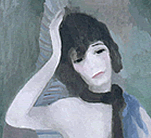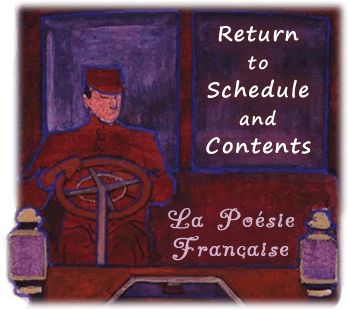|
|


|
|
   I N T R O D U C T I O N : La Lecture What Is Poetry? Poetry is . . . .Webster's Dictionary » POETRY is writing that formulates a concentrated imaginative awareness of experience in language that is chosen and arranged to create a specific emotional response through meaning, sound, and rhythm. A poem is . . . .Webster's Dictionary » POEM is a composition in verse. A poet is . . . .Webster's Dictionary » POET is one who writes poetry The Elements, or Tools of Poetry Poetry is meant to be read aloud for the words are chosen for their sounds and their connotations. Line arrangements create special effects to communicate perspectives (different points of view), emotions and feelings, and experiences. To create poetry, writers employ special elements of style, the tools of the craft. These elements (these tools) convey the sounds, the imagery, the perspectives (points of view), the emotions and feelings, and the experiences. Alliteration » Repetition of the beginning consonant sounds to emphasize words, to tie lines together, to reinforce meaning, and to add sound effects. Assonance » Repetition of vowel sounds within two or more closely positioned words to unify poetry (and prose) while providing interesting sound patterns. Consonance » Repetition of consonant sounds within words to unify poetry (and prose) while providing interesting sound patterns Example: Walt Whitman, "When I Heard the Learn’d Astronomer." Figurative Language » Conveys ideas beyond the literal, ordinary meaning of words and is most often used as simile, metaphor, personification, or hyperbole. Imagery » Refers to details that appeal to the five senses, often in a startling way, as well as for other senses Rhyme » The repetition of sounds at the end of words. Internal rhyme: within a line of poetry. End rhyme: at the end of a line of poetry. Off-rhymes: words that do not rhyme exactly. Rhythm » The pattern of accented and unaccented syllables which brings out the musical quality of language. It can create mood and emphasize ideas. Syllables can be stressed or unstressed. If indicated on a poem, stressed syllables are marked ´ and unstressed syllables are marked ˇ . Meter » The regular pattern of stressed and unstressed syllables in a line of poetry which can emphasize the musical quality of the language. Also can be used to emphasize particular words or ideas to create a certain mood Speaker » The voice that addresses the reader, similar to a narrator of a story. The speaker is not necessarily the voice of the poet. Theme » An insight about life or human nature. Some poems are purely art d’agrément. Serious works have at least one point about life or the human condition. Kinds of Poems Some poems follow strict rules for form, for rhythm, and for rhyme. Others that follow no rules are written in free verse — poetry without regular patterns of rhyme and of meter. Free verse often sounds like everyday conversation when read aloud. Some poems tell stories. La Ballade/Ballad » un poème long - a narrative composition in rhythmic verse suitable for singing; a fixed verse form consisting usually of three stanzas with recurrent rhymes and an identical refrain for each part. L’Élégie (f)/Elegy » A song or a poem expressing sorrow or lamentation especially for someone who has died (pensive, reflective). L’Épigramme (f)/Epigram » A concise poem dealing pointedly and often satirically with a single thought or an event, often ending with an ingenious turn of thought. La Fable / Fable » A narration intended to enforce a useful truth, especially one in which animals speak and act like humans; a fictitious narrative, a legendary story of supernatural happenings. Les Fables de Jean de la Fontaine (Classicisme). L’Hymne (m)/Hymn » A song of praise or joy; a metrical composition adapted for singing, often in a religious service. Le Lai / Lay (poésie) » A simple, narrative poem similar to a ballad. Le Poème Lyrique / Lyric Poem » A short poem expressing the thoughts and feelings of a single speaker. La Stance / Stanza » A type of verse form of a lyrical poem. Le Madrigal / Madrigal (musique) » A medieval short lyrical poem in strict poetic form. Le Poème en Narration / Narrative Poem » A poem that tells a story. L’Ode (f)/Ode » A lyric poem which is usually marked by exaltation of feeling and of style, varying length of line and complexity of stanza forms. Le Sonnet / Sonnet » A fourteen-line poem that follows a precise pattern. Most English sonnets are divided into three four-line units called quatrains and end with two rhymed lines (a couplet). The three quatrains express three different but related thoughts. The couplet provides the conclusion. Les Sonnets de William Shakespeare. Literary Terms Literary terms are needed in order to discuss poetry. Easily recognized are the cognates: un poème, un poète, la poésie, la rime, le rythme. Other terms must be learned: une strophe, (stanza), un quatrain (une strophe de quatre vers), un tercet (une strophe de trois vers), and un sonnet (un poème de quatorze vers: deux quatrains et deux tercets). In the traditional French sonnet, chaque vers (each line) consists of twelve syllables which is called l’alexandrin (alexandrine), so named because it was used in a twelfth-century Old French poem about Alexander the Great. (Consult The Poetry Resource Guide for added explanations.)  The Author:

Different languages — I mean the actual vocabularies, the idioms — have worked out certain mechanisms of communication and registration. No one language is complete. A master may be continually expanding his own tongue, rendering it fit to bear some charge hitherto borne only by some other alien tongue, but the process does not stop with any one man. While Proust is learning Henry James, preparatory to breaking through certain French paste-board partitions, the whole American speech is churning and chugging, and every other tongue doing likewise.
|
|
Planet Gnosis is directed by Dr. Freddie A. Bowles, Assistant Professor of Foreign Language Education in the Department of Curriculum and Instruction, the University of Arkansas at Fayetteville. Planet Gnosis is dedicated to the exploration of education and teaching. It is a cybersite of CornDancer.com, a developmental web for the Mind and Spirit. Submissions are invited. |

